Against All Oddities: The Car Nerd’s Guide to Istanbul
My parents recently told me about their trip to Istanbul with our extended family, during which the group hired a guide to help navigate the city. Regular Against All Oddities readers know that such a move isn’t exactly my style; my wife and I tend to embrace chaos in our travels, and not everyone enjoys roadside bartering for homemade snacks and/or directions in exchange for sh**box diagnostics. But if you like the safety and predictability of a plan, having someone to navigate the absolute insanity of such a city makes sense.
The conversation got me thinking…what if I were the guy holding the flag and bullhorn? What would an Against All Oddities tour of Istanbul look like? Instead of guaranteeing stability and predictability, my job would be to secure automotive shenanigans, to seek out those dark urban corners rich with abandoned vehicles, auto shops, and parts houses. Stops for the odd chai and kebab would be encouraged.
OK everyone, gather around the burned-out and stripped Murat!
What could there possibly be to see in Istanbul? First off, Turkey rarely gets credit for its homegrown auto industry. I’m not just talking about the Renaults and Fiats built under license, with hard-to-pronounce names, but rather the fiberglass-bodied Skoda pickups and attractive Anadol coupes. These things still outnumber tourists ten to one.
The Against All Oddities walking tour will last north of fourteen hours and approximately 37,000 steps. The jaunt starts at our Airbnb, from there heads up the Bosporus Strait to ritzy Bebek, back through the auto parts district, and returns home through the stabby part of an inner suburb called Taksim. We end when we’re too tired, hungry, or scared to proceed. Matt Tip #1: Try not to look lost!

For our first stop in the residential neighborhood portion of this walk, I would like to introduce what are perhaps the most common cars in Turkey: the Fiat Regata-based Şahin, Doğan, and Kartal. These were made locally into the early 2000s, and they were screwed together in Ethiopia until 2010 as the Holland Docc. A top choice for local boy racers, this car plays a starring role in Turkish culture and national identity. Nearly every rad-era Tofaş on the road sports a slammed stance and a set of Borbet five spokes procured from a local streetside dealer.
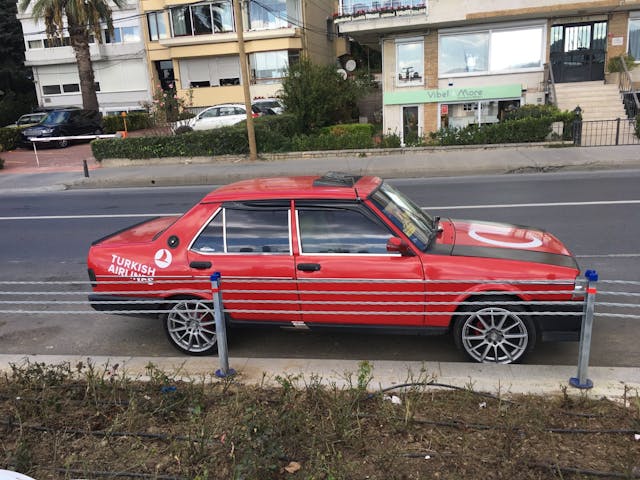
Prior to the Tofaş Şahin, Doğan, and Kartal came the Fiat 131-based Murat. The name means “desirable,” and 8 out of 10 famous street cats of Istanbul agree. These Murats looked much more like a Fiat 131 than the later cars but had some local differences, like the lights and fascia. I must say, they look the business in wagon wheels and white walls. The salty Bosporus air isn’t exactly kind to any licensed Fiat product. Rest assured, I’ll point out every single one on the tour, regardless of the amount of body filler it contains.

Now as we wander aimlessly along the Bosporus and through the well-to-do town of Bebek, I would like to direct you to a local fisherman struggling with his Tofaş Serşe. (Think Fiat 124-based Soviet Lada with a hip new look and rack-and-pinion steering.) We’ve got nothing to lose, so why not try to help? Matt Tip #2: Mind your attitude; the fisherman hate the smell of ego!
Such experiences are a carefully curated part of the tour. Despite the lack of easy verbal communication, let’s quickly pantomime a conversation well enough for him to give me a rundown of the car’s issues. Wild gesticulation, in this case, leads to an ignition switch contact diagnosis. Please try to ignore the watchful eye of his fisherman friends as we dig up under the patriotically adorned dash. A few quick tugs and jiggles is all it takes for us to look like heroes as the motor comes to life. Score one for American-Turkish diplomacy! On to the next!

In my tours, I always try to avoid the high-pressure salesmanship of touristy waterfront seafood restaurants that tend to fling menus in my face. Let’s avoid that area and bound down the hill to the gravel lot where overzealous salesmen park. There, an ordinary Oyak-Renault 21 (think short-lived Eagle Medallion) is ripe for the spotting. This itself isn’t too odd; what gives me pause is that this example is a variant of the Turkish 21, called the Optima, that has a transverse 1.4-liter motor and shorter wheelbase than all other 21s! When Renault realized that 1.4 liters wouldn’t acceptably motivate such a car, it extended the front and adapted a longitudinally mounted transaxle that would accommodate the ground-pounding 1.7-liter. Matt Tip #3: Nothing fun or exciting comes of tourist traps!

Never one to risk the lives of my tour group, I always err on the side of safet… Is that a Dacia pickup?! Safety can’t be allowed to interfere with such a sighting, even if it’s on the other side of a six-lane highway! Let’s go! On the other side of traffic stands a crew-cab Romanian Dacia; admittedly this is not Turkish, but it’s too odd not to highlight. Starting in 1975 and running to 2005, this example was from the final year of production for the Dacia 1307 four-door long bed Pickup. Optioned with the olive-stump-pulling Renault 1.9-liter TurboDiesel, the final 1307s represented the final iteration of the impossibly long-in-the-tooth Renault 12. With several of the dash lights illuminated, and with no key present (a travel-first for me), the $1800 ask seems optimistic.
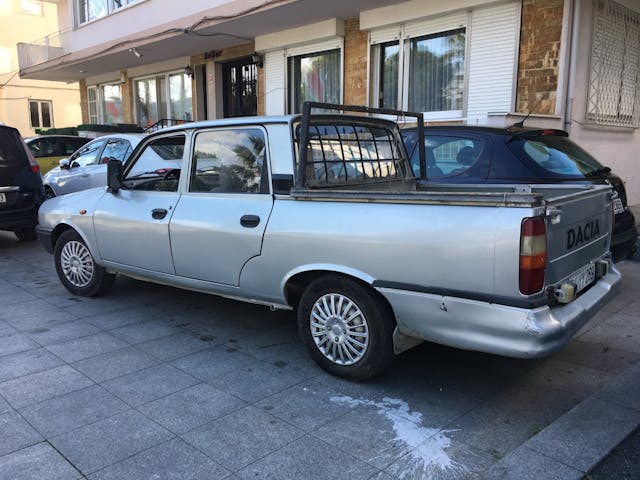
Let’s venture now into the auto parts district of Taksim. For those of you who are homesick already, or crave global McDonalds menu variants when abroad, here’s a welcome surprise: a store full of ’50s Chevy parts. Let’s step down off the chaotic street scene and into the dimly lit parts house, called Klasik Amerikan. Access is gained by me, your guide, displaying phone pictures of my uncle’s ’58 Impala and whining until I get a tour.
American iron was thick on the ground back in Turkeu’s day, and taste for the stars and stripes endures in cult form here in the former Constantinople. It’s exceedingly odd trying to talk Tri-Five Chevrolets over a language barrier, but enthusiastic arm waving is better than nothing. Via automotive sign language and Google translating, it is clear that Klasik Amerikan could get or make anything anyone would need trying to restore an old Chevy in Anatolia. Anyone need any custom-trim souvenirs?

In a similar plea to appease the homesick, I’d like to direct your eyes to a Dodge that’s sometimes called a DeSoto. The AS250 2.5-ton truck, equipped with the Perkins Phaser 90-hp Diesel and 5 “Vitres” is indeed an odd find befitting of this tour. Askam, the manufacturer of trucks and commercial vehicles that built this creation, was only 60 percent owned by Chrysler. The real curiosity is that these were also sold as DeSotos, in Turkey, into the 1990s. How the DeSoto name still had any recognition 1990s Turkey is beyond me, but I’m glad it happened!
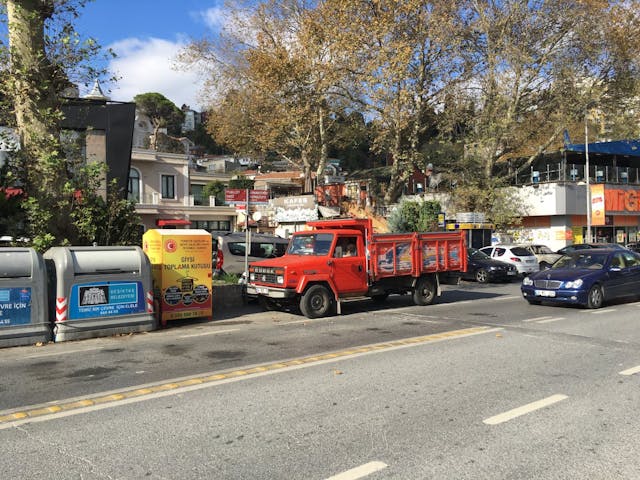
Now, venturing into the worst parts of a city often yields the most interesting finds! Matt Tip #4: Phones in the inside jacket pockets and wallets in your underwear, please! Here at AAO tours, we find the worst areas for you and don’t mind risking robbery if the reward seems promising. The highest density of classic cars to be seen is in the industrial Northern end of the town of Taksim. This area is so walkable that people start following you!
Alas, our first find: any car with tennis shoes on the hood warrants a closer look. This attractive fiberglass two-door is an Anadol A1 Akdeniz MkII. An odd meeting of the minds at Turkish Ford (called Otosan) and a pair of British firms called Relient and Ogle created the slick Anadol Coupe. For those needing more practicality, there were plastic-paneled pickups, sedans, and wagons to choose from, too. This one is somewhere between a ‘72 and ‘75, as the lights are from Lucas and the front bumper is an integrated element, like an Anatolian GTO. Just down the street, another example in similar condition awaits rescue. Guarded by an extremely intoxicated gentleman, we’re free to snap a few quick photos between his lucid moments.
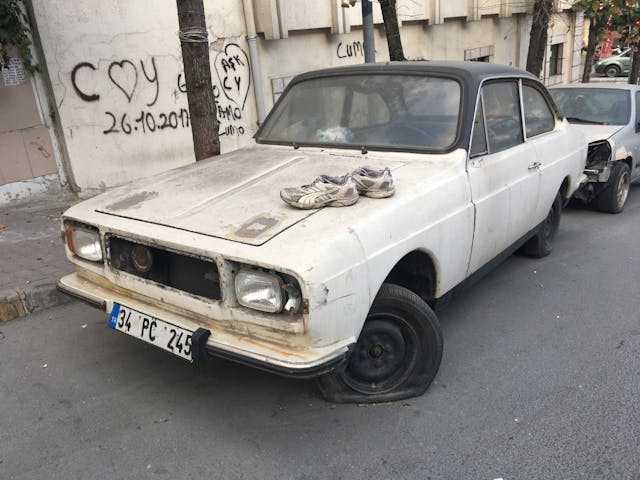
I’d like to take a quick pause here at one of Istanbul’s many souvenir shops. See a memento worth smuggling away for that special 4x98mm bolt pattern at home? Say, if anyone heading to Charlotte Douglas International Airport has any room in their luggage for a set of wide Borbet “A” Classics, I’ll offer a 5 percent discount on the tour! The sleepy gentleman in the recliner is always happy to work out a bargain for tour groups.

Keep stepping everyone, and quickly please. Rolling stones gather no mobs! Let’s check out this textbook partnership gone awryL Back in the ’60s, British Motor Company started a Turkish affiliate. The venture got bought by a local conglomerate and the English partnership was soon dissolved. But amid the hustle the purchasing entity seemingly forgot to mandate a name change, and the “new” Turkish BMC started making models under the familiar moniker. The edgy white van is a BMC Levand XLC. Though our European guests might say it looks like Mercedes MB100 “Cutter,” it’s in fact an unauthorized carbon copy native to Turkey that runs a Nissan engine. A city full of interesting history!
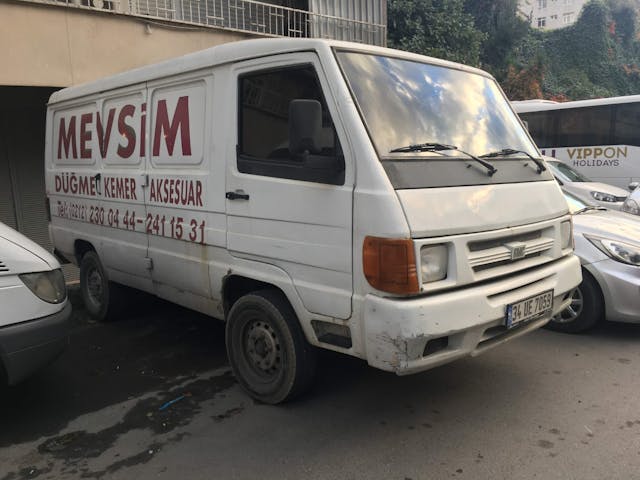
Russian cars aren’t terribly common in Istanbul. After all, Turkey has its own Zhiguli equivalent. But have a look over there at the entrance to the scrapyard. Just next to the man carefully dissecting a scrap washing machine with a sledgehammer sits a very familiar Lada 110, or the Lada Vega as it is known in Turkey. Whether the local market Vegas came from Romanian, Ukrainian, or Russian AutoVAZ production, I have failed to ascertain. (No refunds on the tour.) But what we can judge by the second Vega driving by is that hold six people in relative discomfort. Though resembling a two-story Renault, these cars were a big step up over the humble Samara. Surprisingly, the body and cylinder head were co-developed between AutoVAZ and Porsche Engineering. Even more shocking, they were campaigned in WTCC into the 2000s.

Who could possibly call a tour of Istanbul complete without an exhaustive explanation of locally built Renault products? Some of you might remember the Kenosha-built Renault Alliance. But take away the big federal bumpers and AMC construction and you have the Opron-styled Renault 9. Add grandiose nomenclature, bolt it together in Bursa, and it’s the Oyak-Renault Fairway and Broadway. If we’re lucky enough, we might even see an example of the Turkey-only Phase 4, which was built domestically until 2000. If you look to your left, you can see a fine example of a Fairway undergoing some butt-dyno testing through the foot traffic. Clearly, a local is trying to dial in the carburetor for maximum Tofas stoplight sniping.
At our final stop on Auto Skid Row sits one of the more reputable shops on the strip. A local expert hammers away at the fender of this tangerine-colored Oyak-Renault 12 wagon. Matt Tip #5: Ask for permission when it comes to photography! (*Smiles and points at camera*) Thumbs up? Ok, we’re good! You never can be too careful around a man with a hammer working on a Turkish car. The Turkish production of the Oyak-Renault 12 remained until the year 2000 with the slightly facelifted Toros.
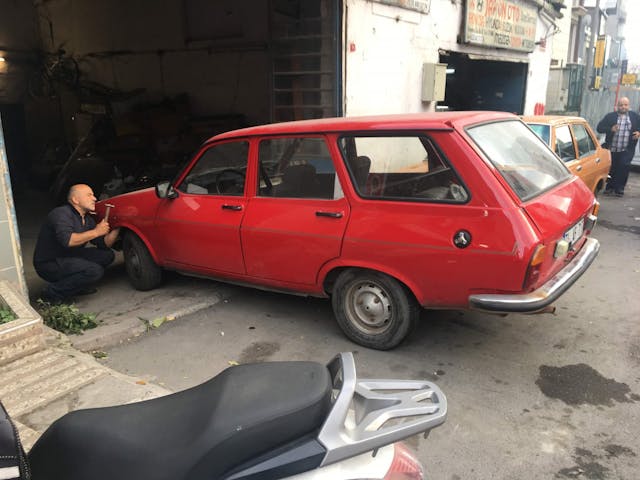
Ok, let’s get out of here and grab a lahmacun! No seriously, RUN!
The tour stops here, my friends. Thanks folks! With your remaining hours here, I invite you to buy a rug or visit a mosque to soak in more local culture.
I’ll admit, I have left off a few stops. I learn from my missteps and try not to let any of my tour-goers experience them. For example, I have spared you from witnessing me peel off to get a haircut, misinterpret the offerings, and end up getting my nose and ear hairs ripped out while my face is painted green, bagged, steamed, and wet-sanded. For three hours. Oh well, I spent that $30 so that you wouldn’t have to. I also stopped at the baths and ended up getting a massage from a truck driver. Matt Tip #6: You can skip that.
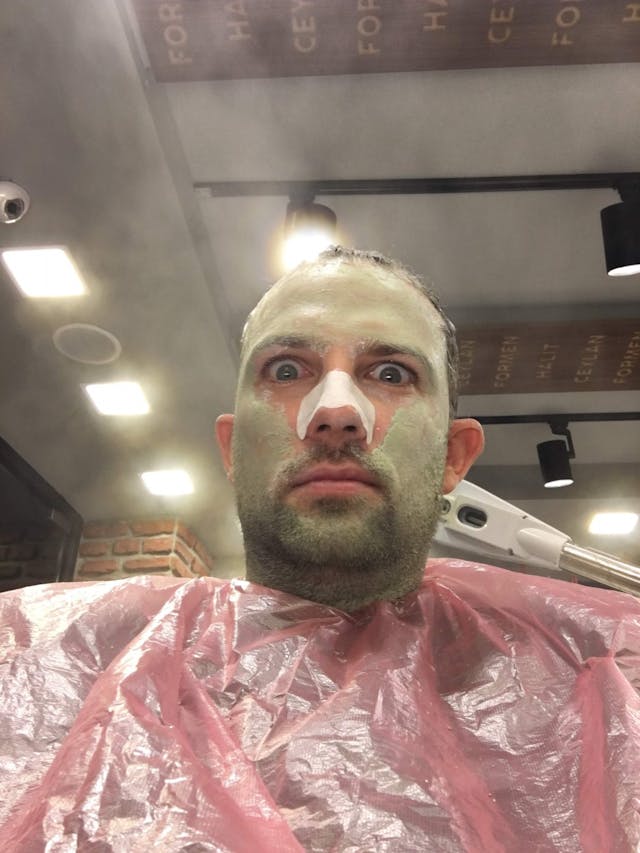





























































































They Might Be Giants was just looping through my head this entire article.
Excellent work! I’d take your tour any time.
Ha! I know that one!
Came to post a They Might Be Giants response. Glad to see i wasn’t the only one. 🙂
Matthew, creative to say the least, but you being a fan of eastern block or near eastern block country’s, can you explain why there is graffiti on every home or building in your pictures, is it a cultural thing or do the residents just not take pride in their homes?
That’s a good question and one I don’t really know the answer to. In general I’ve noticed the lower the GDP or exchange rate, the more the graffiti.
I’m not sure where they are but there is a group or wealthy men there that buy many racing parts from me. It has been a couple years but they would buy parts and ship them to a yacht in the harbor. It saved taxes as it was under another nation flag.
I asked what they were doing with the part and engines. The were racing some place out of town. They used to buy used up Trans Am cars but found they could buy NASCAR cars and they would race them at a track for fun.
I could just picture these guys running old cup cars over there. It has to be a sight.
As many complain about the way things are in the world, I respond we are not one world. It is a bit different every place you go even in your own state. We all adapt.
In 2000 I worked in Istanbul on a Ford project that became the first Transit Connect. At the time, Ford had a large presence. They made Escorts and Transit van at a huge plant in Istanbul, guarded by weapon toting guards. The Koch family was in a joint venture with Ford, and they stored a lot of antiquities in a building on the premises. It was thrilling to hold Sumerian coins and think about how old they were.
The cabs were almost entirely Dogans. There were plenty of Escorts and Transit vans in city traffic.
I think Ford closed that plant and moved to a new one outside of Istanbul. The Transit Connect is no longer made in Turkey. It has moved to Spain.
Wonderful tour, Matthew – like none I’ve ever been on! It’s really intriguing to learn about all of the mixing of automotive DNA out there.